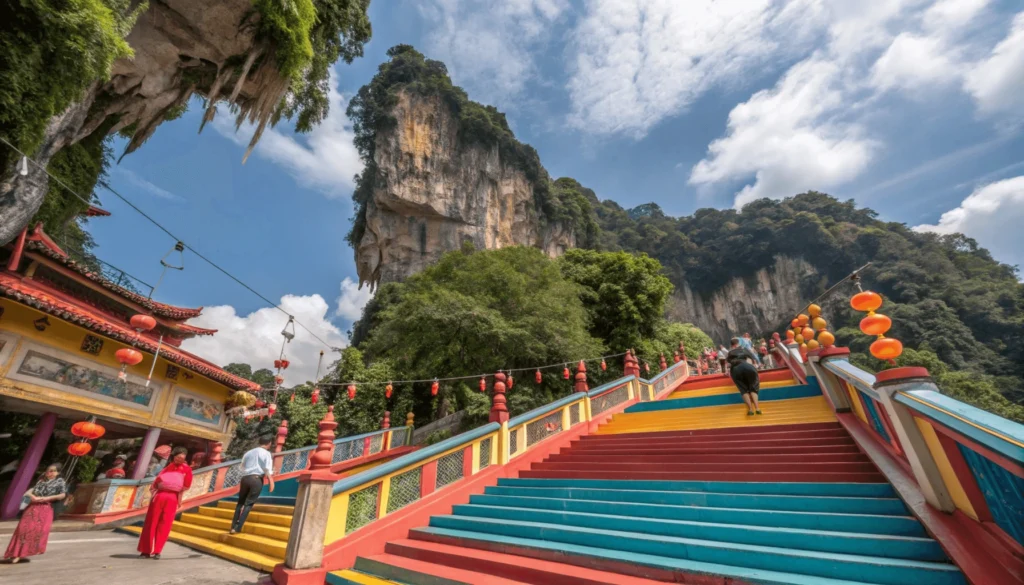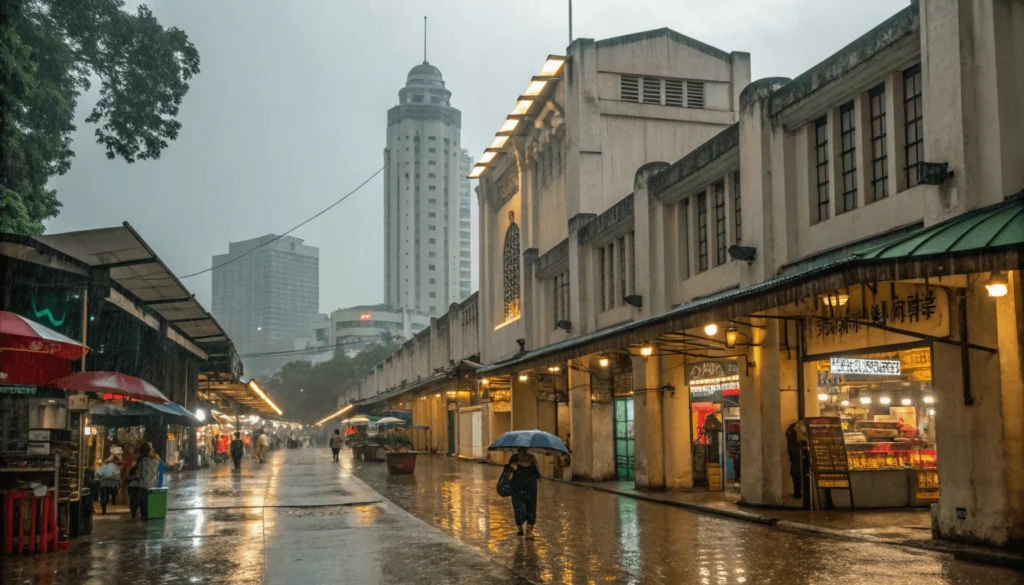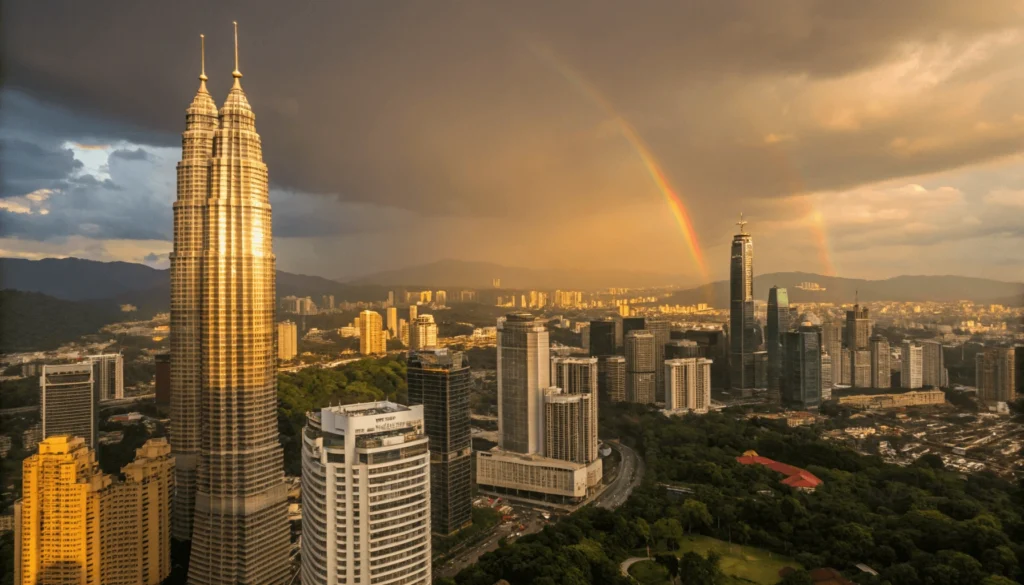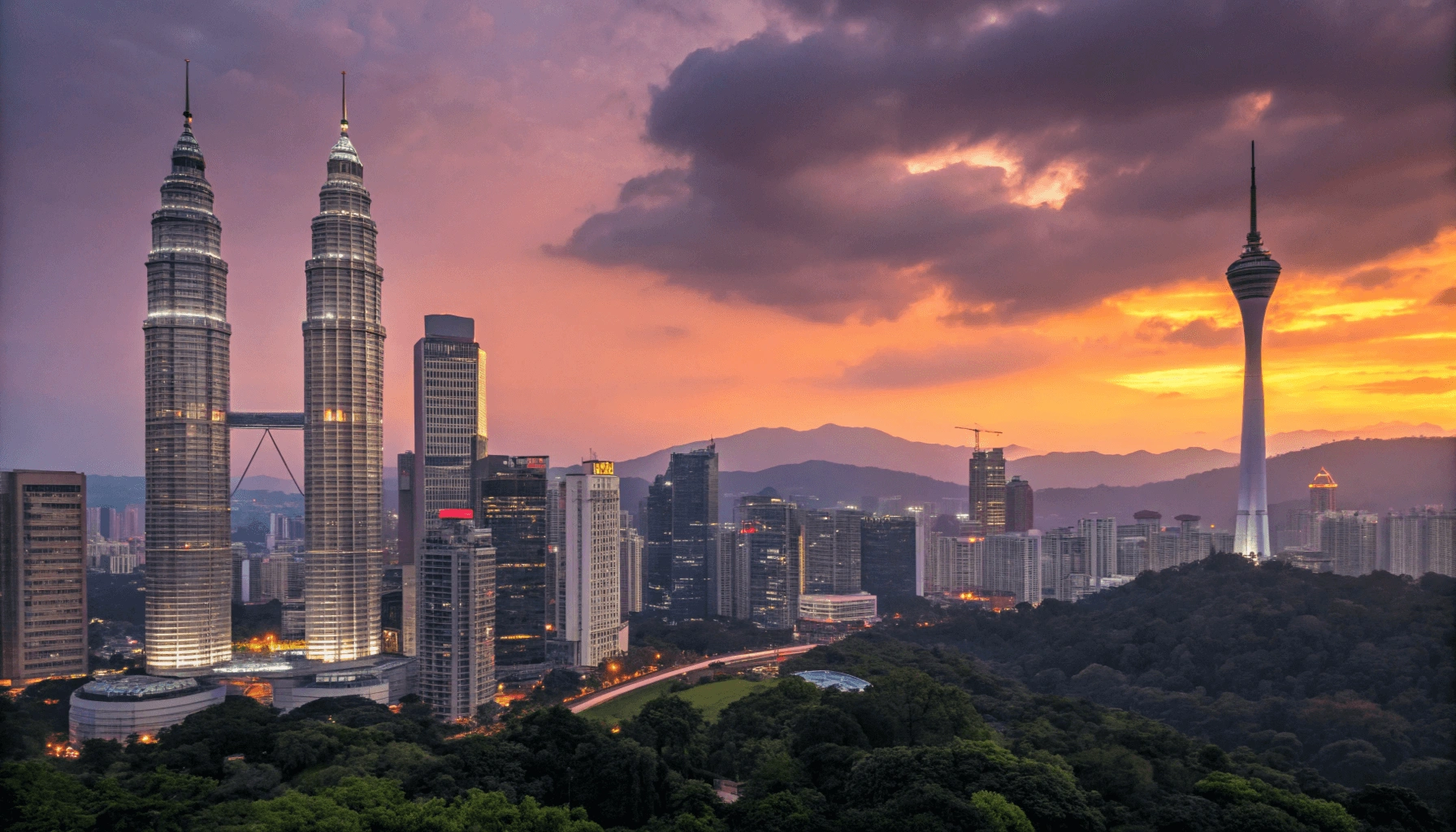Introduction
Towering skyscrapers punctuating a vibrant cityscape, aromatic street food wafting through bustling night markets, and a melting pot of cultures creating a unique urban tapestry – welcome to Kuala Lumpur, Malaysia’s dynamic capital that seamlessly blends tradition with modernity.
TL;DR: Generally, the best time to visit malaysia kuala lumpur for drier weather and pleasant conditions are June-August and January-February. However, KL is a year-round destination, with distinct advantages each season. This guide breaks it all down with details on weather patterns, crowd levels, costs, and can’t-miss cultural events throughout the year. “best time to visit malaysia kuala lumpur”
This comprehensive guide explores everything you need to know about timing your visit to Kuala Lumpur perfectly – from analyzing monthly weather patterns and seasonal crowd fluctuations to identifying budget-friendly travel windows and highlighting the city’s most spectacular cultural celebrations.
Table of Contents
Why Trust This Guide?
This analysis draws on historical meteorological data from Malaysia’s Meteorological Department, on-the-ground research, conversations with local tourism experts, and aggregated visitor experiences to provide you with the most accurate and practical information possible. Updated for 2025, this guide reflects the latest trends and conditions in Kuala Lumpur’s tourism landscape.
Understanding Kuala Lumpur’s Climate: Not Your Typical Seasons
Positioned just 3 degrees north of the equator, Kuala Lumpur experiences a classic equatorial climate characterized by consistently high temperatures (averaging 28-32°C/82-90°F year-round) and considerable humidity (typically ranging from 70-90%). Unlike destinations with four distinct seasons, KL’s weather patterns revolve primarily around rainfall variations rather than temperature shifts. “best time to visit malaysia kuala lumpur”
The city’s climate is influenced by two monsoon periods:
- Southwest Monsoon (May to September): Generally brings slightly drier conditions to KL
- Northeast Monsoon (November to March): Brings more rainfall, especially to eastern coastal regions
It’s worth noting that Kuala Lumpur’s inland, valley location provides some shelter from the full force of monsoon effects compared to coastal areas. While the city experiences higher rainfall during certain periods, the precipitation often manifests as short, intense afternoon thunderstorms rather than days of continuous downpour. “best time to visit malaysia kuala lumpur”
Kuala Lumpur Weather Month-by-Month Deep Dive
Visiting Kuala Lumpur in January
| Weather Metric | Data |
|---|---|
| Average High Temperature | 32°C / 90°F |
| Average Low Temperature | 23°C / 73°F |
| Average Rainfall | 147mm / 5.8 inches |
| Average Rainy Days | 11 days |
| Humidity Level | High (80-85%) |
What to Expect: January marks the beginning of a drier period in Kuala Lumpur, with rainfall starting to decrease after the northeast monsoon peak. Daytime temperatures remain warm, creating pleasant conditions for exploring both indoor and outdoor attractions.

Pros:
- Relatively lower rainfall compared to preceding months
- Perfect window for visiting popular outdoor attractions like Batu Caves and KL Forest Eco Park
- Chinese New Year preparations begin (if falling in January that year)
Cons:
- Can still experience some heavy but brief afternoon showers
- Moderate tourist numbers as it’s the start of a popular visiting period
Key Events/Festivals:
- Thaipusam (if falling in January – dates vary by lunar calendar)
- Chinese New Year preparations and celebrations (if falling in January)
Visiting Kuala Lumpur in February
| Weather Metric | Data |
|---|---|
| Average High Temperature | 33°C / 91°F |
| Average Low Temperature | 23°C / 73°F |
| Average Rainfall | 136mm / 5.4 inches |
| Average Rainy Days | 10 days |
| Humidity Level | Moderate to High (75-80%) |
What to Expect: February continues the favorable weather trend with warm days, slightly decreased humidity, and among the lowest rainfall averages of the year. This makes it one of the most comfortable months to visit Kuala Lumpur for outdoor activities. “best time to visit malaysia kuala lumpur”
Pros:
- One of the driest months in KL
- Slightly more comfortable humidity levels
- Ideal for city walking tours and outdoor activities
Cons:
- Growing tourist numbers as word spreads about the favorable conditions
- Potential price increases for accommodations in popular areas
Key Events/Festivals:
- Chinese New Year (if falling in February – dates vary annually)
- Federal Territory Day (February 1) with local celebrations and events
Visiting Kuala Lumpur in March
| Weather Metric | Data |
|---|---|
| Average High Temperature | 33°C / 91°F |
| Average Low Temperature | 24°C / 75°F |
| Average Rainfall | 217mm / 8.5 inches |
| Average Rainy Days | 14 days |
| Humidity Level | High (80-85%) |
What to Expect: March sees the beginning of a transitional weather period with increasing rainfall. Temperatures remain consistent, but afternoon thunderstorms become more frequent, especially in the latter half of the month.
Pros:
- Vibrant greenery throughout the city as plants respond to increased rainfall
- Slightly smaller crowds as peak tourist season winds down
- Good deals start appearing for accommodations
Cons:
- Increasing rainfall with more frequent afternoon storms
- Higher humidity levels returning
Key Events/Festivals:
- International Women’s Day celebrations
- Malaysia Water Festival activities

Visiting Kuala Lumpur in April
| Weather Metric | Data |
|---|---|
| Average High Temperature | 33°C / 91°F |
| Average Low Temperature | 24°C / 75°F |
| Average Rainfall | 264mm / 10.4 inches |
| Average Rainy Days | 16 days |
| Humidity Level | Very High (85-90%) |
What to Expect: April is typically among the rainier months in Kuala Lumpur. The inter-monsoon period brings increased precipitation and humidity, with thunderstorms becoming a regular afternoon occurrence. Morning activities are generally safer from rain interruptions.
Pros:
- Lower tourist numbers mean better deals on accommodations
- Less crowded attractions
- Lush, vibrant greenery throughout the city
Cons:
- One of the rainiest months
- Very high humidity levels
- Outdoor activities require flexible planning
Key Events/Festivals:
- Vaisakhi celebrations by the Sikh community
- Earth Day events and environmental activities
Visiting Kuala Lumpur in May
| Weather Metric | Data |
|---|---|
| Average High Temperature | 33°C / 91°F |
| Average Low Temperature | 24°C / 75°F |
| Average Rainfall | 210mm / 8.3 inches |
| Average Rainy Days | 15 days |
| Humidity Level | High (80-85%) |
What to Expect: May continues to experience considerable rainfall as KL transitions toward the Southwest Monsoon. However, rainfall amounts begin to decrease slightly from April levels, offering more opportunities for outdoor exploration between showers.
Pros:
- Gradually decreasing rainfall compared to April
- Fewer tourists mean more authentic local experiences
- Good deals on flights and accommodations
Cons:
- Still relatively high rainfall
- Consistent high humidity
- Afternoon thunderstorms remain common
Key Events/Festivals:
- Labour Day (May 1) with various activities
- Vesak Day (Buddhist celebration – dates vary)
- Royal Floria Putrajaya flower festival (dates may vary)
Visiting Kuala Lumpur in June
| Weather Metric | Data |
|---|---|
| Average High Temperature | 32°C / 90°F |
| Average Low Temperature | 24°C / 75°F |
| Average Rainfall | 130mm / 5.1 inches |
| Average Rainy Days | 10 days |
| Humidity Level | Moderate to High (75-80%) |
What to Expect: June marks the beginning of one of KL’s drier periods as the Southwest Monsoon takes effect. Rainfall decreases significantly, creating better conditions for exploring the city, though afternoon showers can still occur. “best time to visit malaysia kuala lumpur”
Pros:
- Significantly less rainfall
- More reliable conditions for outdoor activities
- Good balance between pleasant weather and moderate tourist numbers
Cons:
- Can coincide with European summer holidays, bringing more tourists
- Still fairly humid despite decreased rainfall
Key Events/Festivals:
- Hari Raya Aidilfitri/Eid al-Fitr (if falling in June – dates vary by Islamic calendar)
- Dragon Boat Festival (dates vary)

Visiting Kuala Lumpur in July
| Weather Metric | Data |
|---|---|
| Average High Temperature | 32°C / 90°F |
| Average Low Temperature | 23°C / 73°F |
| Average Rainfall | 150mm / 5.9 inches |
| Average Rainy Days | 12 days |
| Humidity Level | Moderate to High (75-80%) |
What to Expect: July continues the relatively drier trend with warm temperatures and manageable rainfall levels. While afternoon showers remain possible, they’re typically short-lived, allowing for reliable sightseeing and outdoor activities. “best time to visit malaysia kuala lumpur”
Pros:
- Relatively low rainfall makes outdoor exploration more predictable
- Comfortable evenings for night markets and street food adventures
- Great conditions for day trips to surrounding areas
Cons:
- Peak international tourist season brings more visitors
- Potential for higher accommodation prices
Key Events/Festivals:
- KL Fashion Week (dates may vary)
- Various food festivals and cultural events
Visiting Kuala Lumpur in August
| Weather Metric | Data |
|---|---|
| Average High Temperature | 32°C / 90°F |
| Average Low Temperature | 23°C / 73°F |
| Average Rainfall | 160mm / 6.3 inches |
| Average Rainy Days | 13 days |
| Humidity Level | Moderate to High (75-80%) |
What to Expect: August maintains the favorable conditions with manageable rainfall and typical KL temperatures. The Southwest Monsoon continues to provide relatively stable weather, making this another good month for visiting the city. “best time to visit malaysia kuala lumpur”
Pros:
- Continued favorable weather conditions
- Perfect for exploring KL’s outdoor attractions and parks
- Ideal conditions for photography of the city skyline
Cons:
- High season for international tourists
- Higher prices for premium accommodations
- Popular attractions may be crowded
Key Events/Festivals:
- Merdeka Day/Independence Day (August 31) with parades and celebrations
- National Day countdown events
- Malaysia International Gourmet Festival (dates may vary)
Visiting Kuala Lumpur in September
| Weather Metric | Data |
|---|---|
| Average High Temperature | 32°C / 90°F |
| Average Low Temperature | 23°C / 73°F |
| Average Rainfall | 200mm / 7.9 inches |
| Average Rainy Days | 15 days |
| Humidity Level | High (80-85%) |
What to Expect: September signals a transitional period as rainfall begins to increase with the approaching inter-monsoon period. While the first half of the month often continues August’s favorable conditions, the latter half typically sees more frequent precipitation.
Pros:
- First half of month often continues good weather trend
- Gradually thinning tourist crowds
- Independence Day celebration atmosphere continues
Cons:
- Increasing rainfall, especially in the latter half
- Rising humidity levels
- More frequent afternoon thunderstorms
Key Events/Festivals:
- Malaysia Day (September 16) with patriotic celebrations
- Mid-Autumn Festival/Mooncake Festival (dates vary by lunar calendar)
Visiting Kuala Lumpur in October
| Weather Metric | Data |
|---|---|
| Average High Temperature | 32°C / 90°F |
| Average Low Temperature | 23°C / 73°F |
| Average Rainfall | 264mm / 10.4 inches |
| Average Rainy Days | 18 days |
| Humidity Level | Very High (85-90%) |
What to Expect: October typically brings increasing rainfall as the inter-monsoon period takes full effect. Thunderstorms become more frequent and sometimes intense, though they often clear quickly. Morning activities have better chances of staying dry.
Pros:
- Fewer tourists mean more authentic local experiences
- Better deals on accommodations
- Lush greenery throughout the city’s parks and gardens
Cons:
- One of the rainiest months
- Very high humidity
- Outdoor activities require flexible planning and backup options
Key Events/Festivals:
- Deepavali/Diwali preparations (if falling in October)
- Halloween events at major entertainment venues
Visiting Kuala Lumpur in November
| Weather Metric | Data |
|---|---|
| Average High Temperature | 31°C / 88°F |
| Average Low Temperature | 23°C / 73°F |
| Average Rainfall | 278mm / 10.9 inches |
| Average Rainy Days | 20 days |
| Humidity Level | Very High (85-90%) |
What to Expect: November typically records the highest average rainfall in Kuala Lumpur as the Northeast Monsoon begins to influence weather patterns. Frequent thunderstorms occur, often in the afternoons and evenings, making morning activities preferable. “best time to visit malaysia kuala lumpur”
Pros:
- Low season means great deals on flights and accommodations
- Fewer tourists at major attractions
- Vibrant festival season with Deepavali celebrations
Cons:
- Highest average rainfall of the year
- Very high humidity
- Regular thunderstorms require flexible itineraries
Key Events/Festivals:
- Deepavali/Diwali celebrations (if falling in November)
- Malaysia International Performing Arts Festival (dates may vary)
Visiting Kuala Lumpur in December
| Weather Metric | Data |
|---|---|
| Average High Temperature | 31°C / 88°F |
| Average Low Temperature | 23°C / 73°F |
| Average Rainfall | 232mm / 9.1 inches |
| Average Rainy Days | 17 days |
| Humidity Level | Very High (85-90%) |
What to Expect: December continues to experience considerable rainfall, though slightly less than November. The Northeast Monsoon influence continues, bringing regular afternoon thunderstorms. However, the festive atmosphere throughout the city makes this a vibrant time to visit despite the rain.
Pros:
- Spectacular Christmas and New Year decorations throughout the city
- Fantastic shopping opportunities with year-end sales
- Festive atmosphere at major malls and public spaces
Cons:
- Still one of the rainier months
- High humidity continues
- Price increases around Christmas and New Year
Key Events/Festivals:
- Christmas celebrations throughout the city
- New Year’s Eve countdowns and celebrations
- Year-end shopping festivals and sales
So, When is the Best Time to Visit Kuala Lumpur?
Best Time for Good Weather
If weather is your primary concern, plan your visit during January-February or June-August. These months typically experience lower rainfall amounts, providing more reliable conditions for exploring KL’s outdoor attractions, taking day trips to surrounding areas, and enjoying the vibrant street life the city is known for.
During these periods, you’ll still experience KL’s characteristic warmth and humidity, but with a higher likelihood of clear skies and fewer interruptions from sudden downpours. Morning and evening activities are particularly pleasant, while midday hours remain hot regardless of when you visit.
Best Time to Avoid Crowds
For those prioritizing a more relaxed experience with fewer tourists, consider visiting during March-May or September-October. These shoulder seasons offer a good balance between manageable weather and thinner crowds, especially at popular attractions like Batu Caves, Petronas Towers, and central shopping districts.
While you’ll need to be prepared for more frequent rain showers during these periods, the benefit of shorter queues, more authentic local interactions, and a less hurried atmosphere can be well worth the occasional weather interruption. Plus, KL’s extensive network of covered walkways and indoor attractions makes rain management relatively straightforward.
Best Time for Budget Travelers
To maximize your ringgit, target the low season months of April-May and September-November (excluding major holidays). During these periods, many hotels offer significant discounts, flight prices typically drop, and you’ll find better deals on tours and activities throughout the city.
The cost savings can be substantial – often 20-40% lower than peak season rates – making these months ideal for budget-conscious travelers willing to work around occasional rain showers. Consider booking accommodations with good indoor facilities, as you might spend more time at your hotel during rainfall.
Best Time for Festivals & Events
Kuala Lumpur’s cultural diversity creates a year-round festival calendar, but certain periods stand out for cultural richness:
- January/February: Chinese New Year brings spectacular decorations, lion dances, and festive markets throughout the city, particularly in areas like Chinatown.
- May/June: Hari Raya Aidilfitri (end of Ramadan) features beautiful light displays, open houses, and special foods.
- August/September: National Day (August 31) and Malaysia Day (September 16) bring patriotic celebrations and parades.
- October/November: Deepavali transforms Little India into a kaleidoscope of colors with stunning light displays and cultural performances. “best time to visit malaysia kuala lumpur”
- December: Christmas and New Year celebrations create a festive atmosphere with elaborate decorations throughout the city’s malls and public spaces.
KL’s Peak vs. Shoulder vs. Low Seasons Explained
Peak Season (December-February, June-August)
Kuala Lumpur’s peak tourist seasons coincide with major holidays and better weather conditions:
- December-February: Northern hemisphere winter holidays, Chinese New Year, and relatively drier weather
- June-August: European and North American summer vacations and Southeast Asian school holidays
During these periods, expect:
- 15-30% higher hotel rates, especially at luxury properties
- More advance booking requirements for popular attractions
- Busier public transportation
- Livelier atmosphere at major tourist sites and shopping districts
Shoulder Season (March, May, September)
These transitional months offer a balanced experience:
- Weather conditions in flux – can be favorable but unpredictable
- Tourist numbers noticeably lower than peak periods
- Modest discounts (10-20%) on accommodations
- Less crowded attractions and more available restaurant reservations
Low Season (April, October-November)
The rainiest months see significant drops in tourism:
- Highest rainfall averages and humidity levels
- Best hotel rates with discounts often exceeding 30%
- Near-empty attractions, especially during weekdays
- More opportunities for authentic local interactions
Is There a “Worst” Time to Visit Kuala Lumpur?
While November statistically receives the most rainfall and could be considered the “worst” time weather-wise, it’s important to understand that KL remains perfectly visitable year-round. Even during the rainiest months, several factors mitigate weather concerns:
- Rainfall typically occurs in intense but brief afternoon thunderstorms, not all-day downpours
- Mornings often remain clear even during rainy periods
- Kuala Lumpur offers an abundance of indoor attractions, including:
- World-class shopping malls (KLCC, Pavilion, Bukit Bintang area)
- Museums (National Museum, Islamic Arts Museum, Royal Museum)
- Indoor entertainment (Aquaria KLCC, KL Tower indoor observation deck)
- The city’s extensive network of covered walkways and affordable rideshare options make navigation during rain manageable
Rather than a “worst” time, November-April simply requires more flexible planning and indoor backup options. The substantial cost savings and reduced crowds during these months can actually create a more relaxed, budget-friendly experience.
Practical Tips for Visiting KL (Tailored by Season)
What to Pack
Year-round essentials:
- Lightweight, breathable clothing (cotton, linen, moisture-wicking fabrics)
- Comfortable walking shoes
- Modest attire for visiting religious sites (shoulders and knees covered)
- Sun protection (hat, sunglasses, sunscreen)
- Reusable water bottle
For drier months (January-February, June-August):
- Extra sun protection
- Cooling neck towel
- Lightweight daypack for longer outdoor excursions
For rainier months (March-May, September-December):
- Compact umbrella or lightweight rain jacket
- Quick-dry clothing
- Waterproof phone case
- Plastic bags for electronics protection
- Water-resistant footwear
Activity Planning
Morning strategies (best for all seasons):
- Schedule outdoor activities early (7-10 AM) to avoid both rain and peak heat
- Visit popular attractions right at opening time for fewer crowds
- Take advantage of early morning light for photography
Rainy season afternoon alternatives:
- Shopping explorations at KL’s extensive mall network
- Museum visits and cultural centers
- Spa treatments and wellness activities
- Cooking classes and indoor food tours
- Café hopping in areas like Bangsar or TTDI
Evening options (good year-round):
- Night markets (particularly Jalan Alor and Bukit Bintang area)
- Rooftop bars for city views (weather permitting)
- Cultural performances and entertainment
- Food tours and culinary explorations

Frequently Asked Questions (FAQ)
What is the rainiest month in Kuala Lumpur?
November typically experiences the highest average rainfall in Kuala Lumpur, with approximately 278mm (10.9 inches) of precipitation spread across about 20 rainy days. October and April follow closely behind. However, even during these months, rain often falls in predictable patterns – typically intense afternoon thunderstorms rather than all-day downpours – allowing for planned morning activities.
Is Kuala Lumpur expensive to visit?
Kuala Lumpur offers exceptional value compared to many global cities. Budget travelers can comfortably explore the city on $40-50 USD per day, including hostel accommodation, street food meals, and public transportation. Mid-range travelers might spend $100-150 daily for better hotels and dining options, while luxury experiences start around $200+ per day. Food costs remain remarkably affordable throughout, with excellent street food meals available for $2-5 USD.
How many days do I need in Kuala Lumpur?
A minimum of 3 full days allows you to experience KL’s highlights, including major attractions like the Petronas Towers, Batu Caves, and central shopping/food districts. However, 5-7 days provides a more comprehensive experience, allowing time for day trips to places like Putrajaya, cultural immersion in different neighborhoods, and a more relaxed pace of exploration. First-time visitors often underestimate KL’s diversity and find themselves wishing for more time.
Is it okay to visit KL during Ramadan?
Visiting Kuala Lumpur during Ramadan offers a unique cultural experience and is absolutely appropriate with minor adjustments. Many restaurants and food establishments remain open for tourists, though some street food vendors may operate limited daytime hours. The evenings come alive with special Ramadan bazaars offering incredible food variety. As a respectful gesture, visitors should avoid eating, drinking, or smoking in public during daylight hours when around locals who are fasting.
Does the monsoon affect flights to KL?
Kuala Lumpur International Airport (KLIA) maintains excellent operations even during monsoon seasons, with minimal weather-related disruptions compared to some other Southeast Asian destinations. The modern facility handles adverse weather efficiently, and serious delays due to local weather conditions are uncommon. However, if your travel includes connections through other monsoon-affected regions or smaller airports on Malaysia’s east coast, building in buffer time is advisable during peak rainfall months.
Conclusion
Kuala Lumpur truly shines as a year-round destination, with each season offering its own unique advantages. For the absolute optimal experience balancing weather conditions, costs, and crowd levels: “best time to visit malaysia kuala lumpur”
- Weather-focused travelers should target January-February or June-August
- Budget-conscious explorers will find the best value during April-May and September-November
- Cultural enthusiasts might prioritize festival periods, particularly around Chinese New Year, Hari Raya, and Deepavali
Whatever time you choose to visit, KL’s dynamic blend of cultures, exceptional food scene, modern infrastructure, and warm hospitality ensures a memorable experience. The city’s extensive indoor attractions and excellent public transportation system make it remarkably adaptable to any weather conditions you might encounter.


